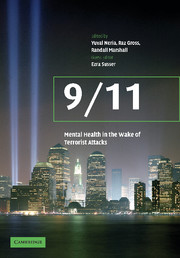Book contents
- Frontmatter
- Contents
- Acknowledgments
- Editors brief bio
- List of contributors
- Foreword
- Part I Introduction
- Part II The psychological aftermath of 9/11
- Part III Reducing the burden: community response and community recovery
- Part IV Outreach and intervention in the wake of terrorist attacks
- Part IV A New York area
- 16 PTSD in urban primary care patients following 9/11
- 17 Project Liberty: responding to mental health needs after the World Trade Center terrorist attacks
- 18 Mental health services support in response to September 11: the central role of the Mental Health Association of New York City
- 19 The New York Consortium for Effective Trauma Treatment
- 20 Evaluation and treatment of firefighters and utility workers following the World Trade Center attacks
- 21 The World Trade Center Worker/Volunteer Mental Health Screening Program
- 22 Child and adolescent trauma treatments and services after September 11: implementing evidence-based practices into complex child services systems
- 23 Relationally and developmentally focused interventions with young children and their caregivers in the wake of terrorism and other violent experiences
- Part IV B Washington, DC
- Part IV C Prolonged-exposure treatment as a core resource for clinicians in the community: dissemination of trauma knowledge post-disaster
- Part V Disasters and mental health: perspectives on response and preparedness
- Index
20 - Evaluation and treatment of firefighters and utility workers following the World Trade Center attacks
from Part IV A - New York area
Published online by Cambridge University Press: 27 October 2009
- Frontmatter
- Contents
- Acknowledgments
- Editors brief bio
- List of contributors
- Foreword
- Part I Introduction
- Part II The psychological aftermath of 9/11
- Part III Reducing the burden: community response and community recovery
- Part IV Outreach and intervention in the wake of terrorist attacks
- Part IV A New York area
- 16 PTSD in urban primary care patients following 9/11
- 17 Project Liberty: responding to mental health needs after the World Trade Center terrorist attacks
- 18 Mental health services support in response to September 11: the central role of the Mental Health Association of New York City
- 19 The New York Consortium for Effective Trauma Treatment
- 20 Evaluation and treatment of firefighters and utility workers following the World Trade Center attacks
- 21 The World Trade Center Worker/Volunteer Mental Health Screening Program
- 22 Child and adolescent trauma treatments and services after September 11: implementing evidence-based practices into complex child services systems
- 23 Relationally and developmentally focused interventions with young children and their caregivers in the wake of terrorism and other violent experiences
- Part IV B Washington, DC
- Part IV C Prolonged-exposure treatment as a core resource for clinicians in the community: dissemination of trauma knowledge post-disaster
- Part V Disasters and mental health: perspectives on response and preparedness
- Index
Summary
The tragic events of September 11, 2001 put the resources of the American people to the test like no other event in US history. The world watched as people came together from all walks of life, from all parts of the country, to clear up the ruin that the terrorists had left behind in lower Manhattan. At the time of the attacks,we found ourselves in the unique position to lend our psychological expertise in the field of trauma to two distinct groups called upon, by profession, to respond to the devastation: the New York Fire Department (FDNY), and employees of Consolidated Edison (Con Edison), the utility company responsible for providing New York City with electricity, gas, and steam. We had a prior history with both of these groups via the primary author's role as liaison between the Weill Cornell Medical College Department of Psychiatry and the New York Presbyterian Hospital (NYPH) Burn Center for the past 15 years. Our involvement with these specific groups stems most basically from the fact that people in these positions undergo trauma via work-related accidents and injuries and require evaluation and treatment for the psychological sequelae of trauma. It was these facts that left us in a position to organize the evaluation and treatment post-disaster, on a scale we had never imagined, to two populations that had never previously been so massively traumatized.
In this chapter we share what we have learned about how these two populations were effected by their exposure to the terrorist attacks and their aftermath.
- Type
- Chapter
- Information
- 9/11: Mental Health in the Wake of Terrorist Attacks , pp. 333 - 354Publisher: Cambridge University PressPrint publication year: 2006



